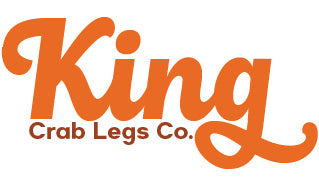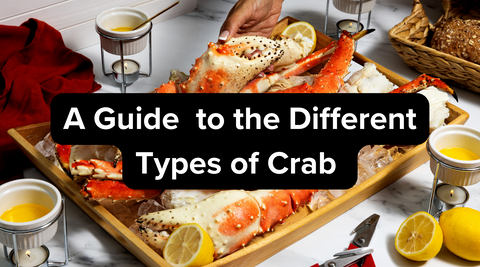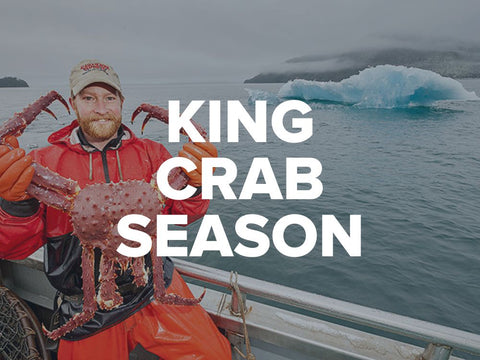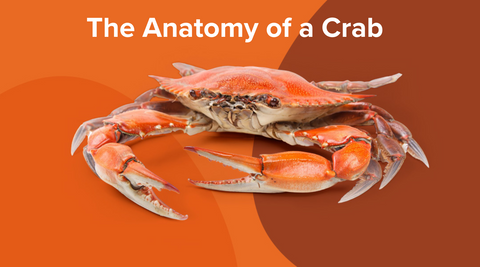A Guide to the Different Types of Crab
There are a range of different types of crab to eat, from snow crab to king crab. While some may be more popular than others, each crab leg type has a distinct flavor. If you're wondering where to begin, look no further. This guide will compare the characteristics of king crab, Dungeness crab and snow crab, as well as others that are a seafood lovers' dream! We'll also explore what each crab tastes like.
King Crab
Also known as the Alaskan king crab or red king crab, the king crab is one of the largest types of crab to eat. Its outer shell is thick, making the legs challenging to crack. To enjoy the delicious meat, you'll need a cracking tool. Explore these characteristics of king crab:
- Size: Weighing between 6 and 25 pounds, a king crab can have a leg span of up to five feet!
- Taste and texture: King crab meat has a rich, sweet flavor that makes cracking through the shell worth it. The tender texture of the meat resembles that of a lobster. King crab legs have smooth ropes of buttery meat that melt in your mouth.
- Color: King crab meat is bright white, surrounded by a vibrant red edge.
- Habitat: The Alaskan king crab resides in a limited habitat and has a set harvesting season. You can find them in the waters of British Columbia, Japan and Alaska, with the Bristol Bay and the Kodiak Archipelago being the centers of its abundance in Alaska. Red king crabs can occur from the intertidal zone to 100 fathoms or more.
- Price: Its short harvesting season, limited availability and decadent flavor make this crab more expensive than other varieties.
- Availability: The harvesting season for the Alaskan king crab is short — from November to January.
- Nutrition: King crabs are high in protein and low in fat. They are also an excellent source of omega-3s, mineral zinc and vitamin B12.
- Preparation: Our king crab legs are fully cooked at the dock and then frozen. Once thawed, you can eat the meat out of the legs immediately. To heat Alaskan king crab legs, you can boil, steam or bake them. The meat is delicious on its own, or you can serve it with lemon, butter and your favorite sauces.
Dungeness Crab
The Dungeness crab gets its name from the Dungeness Spit on the Olympic Peninsula, which shelters a shallow bay that the crabs inhabit. Learn more about the Dungeness crab:
- Size: State laws govern the minimum size of Dungeness crab that fishermen can harvest. Crabs may reach 10 inches across the back, but most are between 6 and 7 inches.
- Taste and texture: This delicacy has distinct sweet and succulent meat with a slightly nutty flavor.
- Color: Dungeness crab has a bluish-purple hue. When cooked, the heat creates a chemical reaction that turns the meat a pinkish shade.
- Habitat: These crabs scavenge the ocean floor, feeding on worms, mussels, small crabs and other tiny organisms. They inhabit the coastal waters stretching from Alaska to Baja, Mexico. The crab is exclusive to the Pacific Ocean, but there have been rare sightings in the Atlantic Ocean as well.
- Price: Dungeness crab is not usually as expensive as king crab.
- Availability: The prime season to harvest the Dungeness crab is winter.
- Nutrition: Dungeness crab is a nutrient-dense delicacy that is low in calories and high in protein.
- Preparation: Reheat your Dungeness crab by steaming or boiling it for 5 to 10 minutes until it is heated through. Season it and use a mallet or hammer to crack it open.
Snow Crab
If you are new to eating crab, the snow crab is a great place to start. It's easy to get the meat out of the shell, and snow crab has a mild flavor, making it a fantastic introduction to crab delicacies.
- Size: The snow crabs have distinct legs that are incredibly long with a thinner body. Male snow crabs can reach 6 inches in shell width, while females can reach 3 inches.
- Taste and texture: Snow crab meat is mild yet sweet with a subtle hint of brine. Its texture is firm and fibrous, making it easy to shred.
- Color: Many people think snow crabs get their name from their habitat, but their meat gives them their name. The meat is red but turns a brilliant, snowy white when cooked.
- Habitat: Snow crabs reside in the North Atlantic and North Pacific oceans. They prefer the deep, cold waters of these parts.
- Price: This crab is an affordable option, which is another factor that makes it ideal for people new to crab.
- Availability: The best time to harvest snow crab is between January and March.
- Nutrition: This crab is low in fat and high in protein and omega-3s. It's also a great source of mineral zinc and vitamin B12.
- Preparation: To reheat this crab, bring a large pot of water to a boil. Add the legs to the water and reduce heat to medium. Boil the legs for 5 minutes or 8 minutes if you have more than 15 legs. Once cooked, remove the legs from the pot, and run them under cold water to prevent overcooking. Extract the meat, and serve with butter or your favorite dipping sauce.
Blue Crab
These crabs are recognizable by their beautiful blue-green hue. Their Latin name — Callinectes sapidus — means beautiful swimmer. Blue crabs are one of the most prolific crabs in the U.S. Learn more about them:
- Size: Blue crabs can have up to a 9-inch shell.
- Taste and texture: This crab is known for its deliciously sweet, delicate flavor and tender meat.
- Color: The blue-green shell color is what makes this crab identifiable. Its meat is white as snow and red at the edges where it touches the shell.
- Habitat: Blue crabs reside in the waters from Nova Scotia to the Gulf of Mexico, Argentina and Uruguay. It is most prolific in the Chesapeake Bay off the coast of Maryland and Virginia — they thrive in the brackish estuaries and salt marshes in these waters.
- Price: The blue crab fetches high prices compared to other varieties.
- Availability: The blue crab is one of the most heavily harvested crabs worldwide. The peak season for this crab is between April and November.
- Nutrition: These crabs are low in fat but packed with protein. They are also a good source of phosphorous, zinc and potassium.
- Preparation: To prepare your blue crab, fill a pot with water and bring to a boil. Add salt and seasoning to your water and then add your claws one at a time. Cook them for 8 to 10 minutes. Once done, place them on a table covered with a cloth. Grab your mallet and start cracking. This crab can be rather messy to eat, but the reward of the sweet, delicious meat makes it worth it.
Peekytoe Crab
This crab is also known as the Atlantic rock crab or the sand crab. It used to be known as a throwaway crab in the fishing industry because it didn't ship well and was a pest in lobster pots. Once people discovered they could steam and pick the meat, it became highly demanded worldwide. Learn more about peekytoe crab:
- Size: These crabs are relatively small in size. They can reach 5 inches wide.
- Taste and texture: Peekytoe crab meat is sweet, salty, delicate and juicy. Its relatively mild flavor makes it popular for salads, dips and crab cakes.
- Color: Peekytoe crabs range in color from yellowish-brown to reddish-purple and have a distinct white belly. These colors resemble sand and rocks in the oceans.
- Habitat: These crabs live in the Northern Atlantic Ocean, from Nova Scotia to Rhode Island. This species resides on the ocean floor, in depths of up to 750 meters. You can find them in shallow waters of up to 20 meters in the northern parts.
- Price: Peekytoe crabs are more expensive because fishermen clean and pick them when caught.
- Availability: These crabs are usually only found between August and November.
- Nutrition: This crab is high in protein and low in fat, making it a delicious low-calorie choice.
- Preparation: This ready-to-eat meat is perfect for adding to classic recipes such as crab cakes or dips once thawed. Mix the meat with mayonnaise, Sriracha, lime juice and celery, and stuff it into a roll to make a variation of a lobster roll.
Jonah Crab
Fishermen once considered the Jonah crab a bycatch — an accidental catch in the lobster industry — but now it is a prized delicacy. This crab is an affordable option compared to other types of crab:
- Size: Male Jonah crabs can reach a width of around 7 inches across their carapace, and female crabs are smaller.
- Taste and texture: Jonah crab meat is sweet and packed with flavor. People love to eat the meat in the claws and legs of the Jonah crab. The texture is heavier than the Dungeness crab, yet flaky and firm. It has a versatile flavor and texture that you can use in various recipes.
- Color: Jonah crabs are red on top with a yellowish underside and dark-tipped claws. Their carapace is rough and has yellowish or light spots.
- Habitat: This crab resides in the Northwest Atlantic Ocean — primarily between Newfoundland and Florida — from intertidal zones to about 640 meters. However, they are usually found in depths of 50 to 300 meters and live in rocky, clay, sand or mud habitats.
- Price: This crab is affordable. Because of its low price, some fisheries mix its meat with Dungeness or blue crab meat.
- Availability: Fishermen harvest Jonah crabs all year — however, fall is the peak season. An Interstate Fishery Management Plan states that commercial fishermen can only catch Jonah crabs that are at least 4 ¾ inches. There are also limits on how many crabs they can catch.
- Nutrition: Jonah crab meat is low in fat and high in protein, and it offers many vitamins and minerals.
- Preparation: These crab claws and meat come cooked. Once thawed, you can enjoy the meat cold. For a warm meal, boil or steam it like a king or snow crab.
Other Types of Crab
Several other varieties of crab are delicacies around the world. The following are notable mentions:
- Brown crab: This crab gets its name from its reddish-brown color. It is a predominant species in Western Europe, found in the North Sea in Norwegian waters and the northern Atlantic Ocean. The claws of a brown crab have white meat, while its body has brown meat.
- Stone crab: Strict harvesting regulations govern the Stone Crab's season, running from October 15th to mid-May. These regulations help protect this rare species, which also makes it expensive. Fishermen pull a single claw from the crab and release it into the ocean. This claw regenerates in 18 months.
- Japanese spider crab: As the name suggests, these crabs reside along Japan's Pacific coast. They are the world's largest crab, with a leg span of up to 13 feet and an average weight of around 40 pounds. The colossal size of this crab makes it a challenge to cook. It's best to steam it over a large pot instead of boiling it.
- Horsehair crab: These crabs are smaller than most, weighing 2.2 pounds, with a carapace width of 4 to 5 inches. Horesehair crabs have hard shells with tiny pointy hair across their bodies, which gives them their names. You can find these crabs in the Pacific and Atlantic oceans. Horsehair crabs are notoriously challenging to get into, but once you get past their shell, you can enjoy sweet, flavorful meat with a dense texture.
- Coconut crab: This enormous crab, also called a robber crab, lives in the Indian and Pacific oceans. Adult coconut crabs are usually about 40 inches long from leg tip to leg tip. They are known to drop coconuts from trees and open them by repeatedly hitting them with their pincers. People often describe the meat of a coconut crab as creamy and similar to peanut butter.
How to Store Crab
When you order crab from Maine Lobster Now, you'll receive it frozen. Store it in the freezer until you're ready to eat it. The crab will keep in the freezer for up to six months. When you're ready to eat your crab, thaw it in the refrigerator for 24 hours before preparing it.
If you need to thaw your crab quickly, immerse it in cool water for 20 to 30 minutes until the contents are flexible. Once you have thawed your crab, it's important to heat and eat it. Avoid refreezing it, as this will compromise the flavor. While thawing your crab, keep it at 38 degrees Fahrenheit or below before cooking.
Order High-Quality Crab From King Crab Legs
Crab is a beloved seafood delicacy rich in protein and nutrients. From Alaskan king crab to peekytoe crab, seafood lovers can enjoy a range of delicious options. At Maine Lobster Now, we pride ourselves in supplying sustainably sourced, high-quality crab. When you order from us, your crab will arrive right to your door. Enjoy fresh crab legs— shop online today!




